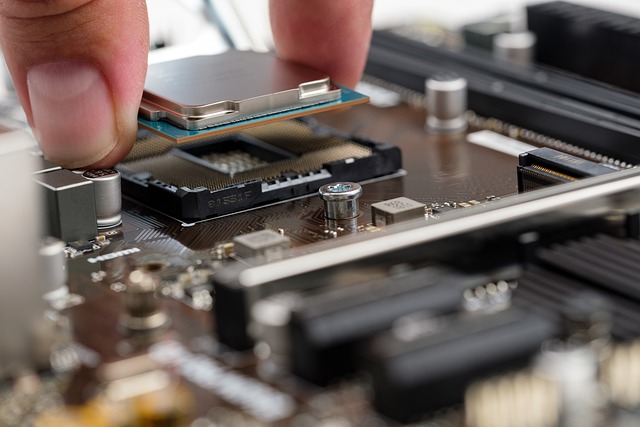
The CPU reads data and instructions from memory, and then stores the results of computations in main memory. The main memory is known as RAM, or random access memory.
Registers, on the other hand, are significantly quicker and smaller than either. Different register types are employed for various purposes.
For example, data registers hold numeric data, but there are also address registers for addresses, status registers for truth values, and so on
You can read more about CPU registers, as well as the distinctions and affinities between registers and CPU cache, in the sections below.
Table of Contents
What’s a CPU?
Knowing the location of a CPU’s data storage without understanding what a CPU is would be prudent, right? Comparable to playing football without understanding the rules
The brain of the computer is called a CPU, also known as a central processing unit. Computers have a central nervous system that governs everything, just like humans. A CPU either executes operations directly, directs other functions to perform them, or may combine the two. This includes accessing data, storing it, and executing it.
Do you see the large fan in the motherboard of your computer? The CPU is located there, yes. There are countless micro transistors and numerous pins, and silicone is primarily used in its construction.
Fun fact: CPU manufacturers have now come up with architectures as small as 5 nanometers. They can store data faster and utilize more transistors as a result. So now that we are aware of what a CPU is and how it looks, we can move on to the important stuff.
Why Does the CPU Need to Store Data Or Computations?
The internal registers, the cache, or the main memory are where the CPU keeps the results of its computations. In order to access or use data more quickly, storing is required.
The CPU would have to fetch data from the HDD each time if computations weren’t stored in this way, and HDDs are incredibly slow, though SSDs are a little bit faster. You would definitely throw your computer out the window if it didn’t have these registers or other fast memory options.
Where Does the CPU Store Its Computations?
The CPU keeps track of its computations in special registers of temporary memory. It utilizes registers because it’s more efficient storing data there than in the CPU cache or even RAM.
You cannot add or remove registers because they are an integral part of the CPU architecture. They are made up of a modest volume of erratic access super-fast storage. Some registers are Read-Only or Write-Only for specific reasons.
Despite not being a part of the main memory (RAM), these temporary forms of memory occasionally receive a memory address. The CPU of your computer accesses data from other, more important types of memory. Then it loads it into registers for computations and storage purposes. In order to make room for new analyses, processed data is typically stored in the RAM (system memory).
Registers and Memory Hierarchy
Have you ever heard of the term Memory hierarchy before? The different types of memory and how they operate are commonly described in computer architecture. As an illustration, hard drives are larger, slower, and more hierarchically positioned types of memory. The CPU registers are the fastest (order of access time) and smallest types of memory. Thus, they are placed at the top of the pyramid, followed by the CPU cache.
The CPU registers have different sizes. The amount of bits a register memory can store determines its size. For instance, the most common register sizes are 8-bit (meaning 8 bits), 12-bit, 16-bit, 32-bit, and 64-bit. Registers can sometimes work in different modes, meaning that a 32-bit register can be split into 8-bit sizes 4 times. It can now store multiple types of data at once thanks to this.
Important Note
The CPU cache and registers are essential parts that must not be disregarded. They are essential for the CPU to function reasonably and effectively. Without cache, CPUs would have to load data from RAM, which would make computers incredibly slow.

How Do Registers Work?
Different register types function in various ways. The main memory or the CPU cache are typically where they store data or addresses to help locate data that is stored elsewhere on the computer.
To better understand the function of index registers in arithmetic tasks, let’s look at an example. Index registers, which are also known as address registers and registers of modification, are storage locations that let the CPU find the needed information. A base, index, and other data are present for these points, or addresses.
Index registers are very helpful because they help the CPU run more efficiently by drastically reducing memory usage and accelerating the execution speed.
Types of Registers
In case you were unaware, there are many different kinds of registers. And they all assist the CPU in carrying out its various operations. The number and types of registers of a CPU depend on its architecture. Some have more significant roles than others.
We’ve mentioned some of these CPU registers below to give you a general idea of how they do. Have a look!
- Constant Registers– They store Read-Only
- Address Registers– Store data addresses, which assist the Locating data in the RAM using the CPU.
- Data Register– They store numeric data used for arithmetic tasks.
- Status Registers– Hold truth values that help the If an instruction should be carried out, the CPU decides.
- Vector Register– They hold data for vector processing.
- Instruction Registers– Store instructions that the Currently, the CPU is working.
A complete list of the various other Register types is available here. All these registers work harmoniously with the CPU to make your computer’s operations efficient, fast, and 100% successful.
Read about
CPU Registers Vs CPU Cache
Registers are even smaller and faster than the cache, which is much smaller and faster than the main memory. On the CPU chip, both can be found. The CPU cache comes in a variety of forms.
The following three are found on almost all modern CPUs:
- Data cache
- Instruction cache
- Translation lookaside buffer (TLB)
When they introduce a new lineup, CPU manufacturers emphasize the data cache. L1, L2, and L3 make up its three layers. L3 is the largest and slowest, while L1 is the fastest and smallest. In order to increase the effectiveness of CPU operations, data is temporarily stored at all levels.
Similar to this are CPU registers, which are even more compact and quick than cache. Some people refer to CPU registers as “L0” cache because of that. Registers store instructions and the data that is currently being used, whereas CPU cache stores recently used data in case it is needed again. Registers, for instance, store interim results when the CPU performs a calculation.
Conclusion
For maximum efficiency, the CPU stores its computations in registers. Registers come in a wide variety of forms and are used for various purposes during intricate operations.
For efficiency and speed, a CPU cache is also crucial. Since a cache is bigger and slower than a register, the most crucial data that is required at the time of an operation is stored in registers. Registers typically hold information or commands that the CPU can use to carry out its tasks. Registers and cache are essential for your CPU to operate as quickly and effectively as possible.



